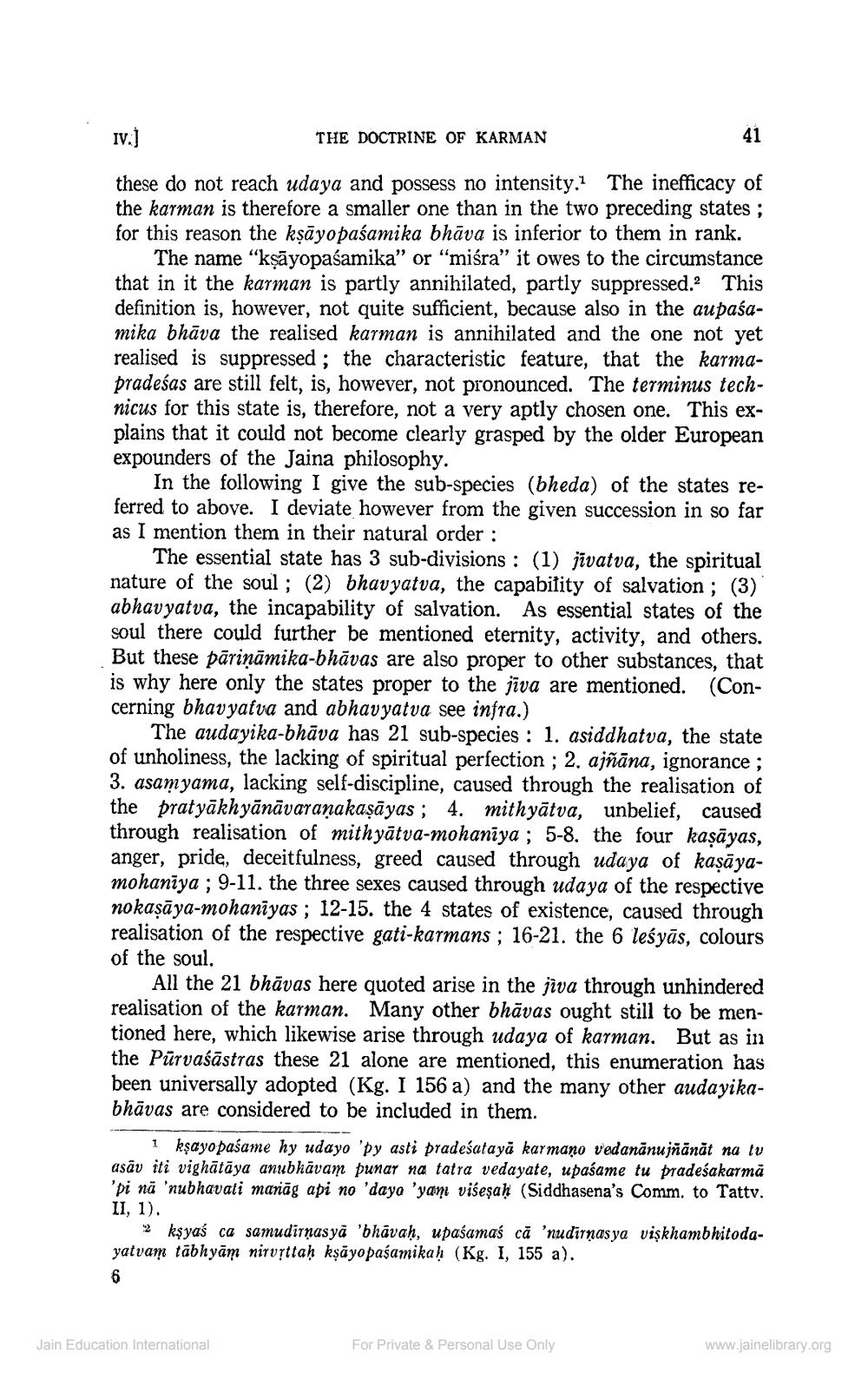________________
IV.)
THE DOCTRINE OF KARMAN
these do not reach udaya and possess no intensity. The inefficacy of the karman is therefore a smaller one than in the two preceding states; for this reason the ksāyopaśamika bhāva is inferior to them in rank.
The name "kṣāyopaśamika" or "miśra" it owes to the circumstance that in it the karman is partly annihilated, partly suppressed. This definition is, however, not quite sufficient, because also in the aupaśamika bhāva the realised karman is annihilated and the one not yet realised is suppressed; the characteristic feature, that the karmapradeśas are still felt, is, however, not pronounced. The terminus technicus for this state is, therefore, not a very aptly chosen one. This explains that it could not become clearly grasped by the older European expounders of the Jaina philosophy.
In the following I give the sub-species (bheda) of the states referred to above. I deviate however from the given succession in so far as I mention them in their natural order:
The essential state has 3 sub-divisions : (1) jivatva, the spiritual nature of the soul ; (2) bhavyatva, the capability of salvation ; (3) abhavyatva, the incapability of salvation. As essential states of the soul there could further be mentioned eternity, activity, and others. But these pāriņāmika-bhāvas are also proper to other substances, that is why here only the states proper to the jīva are mentioned. (Concerning bhavyatva and abhavyatva see infra.)
The audayika-bhāva has 21 sub-species : 1. asiddhatva, the state of unholiness, the lacking of spiritual perfection ; 2. ajñāna, ignorance ; 3. asamyama, lacking self-discipline, caused through the realisation of the pratyākhyānāvaranakaşāyas ; 4. mithyātva, unbelief, caused through realisation of mith yātva-mohanīya ; 5-8. the four kaşāyas, anger, pride, deceitfulness, greed caused through udaya of kaṣāyamohaniya ; 9-11. the three sexes caused through udaya of the respective nokasāya-mohaniyas ; 12-15. the 4 states of existence, caused through realisation of the respective gati-karmans ; 16-21. the 6 leśyās, colours of the soul.
All the 21 bhāvas here quoted arise in the jiva through unhindered realisation of the karman. Many other bhāvas ought still to be mentioned here, which likewise arise through udaya of karman. But as in the Pūrvaśāstras these 21 alone are mentioned, this enumeration has been universally adopted (Kg. I 156 a) and the many other audayikabhāvas are considered to be included in them.
1 kỹayobasame by dayo 'by asti Pradesatayā karmano vedanānumāmặt na tu asav iti vighātāya anubhāvam punar na tatra vedayate, upaśame tu pradeśakarma 'pi nā 'nubhavati manāg api no 'daya 'yam višeşaḥ (Siddhasena's Comm. to Tattv. II, 1).
2 kşyaś ca samudirnasya 'bhavaḥ, upaśamaś că "nudirnas ya vişkhambhitodayatvam tābhyām nirvyttaḥ kṣāyopaśamikaḥ (Kg. I, 155 a).
i na nubhaātāya ambayo
Jain Education International
For Private & Personal Use Only
www.jainelibrary.org




